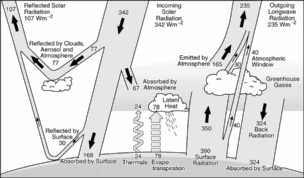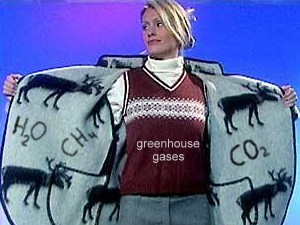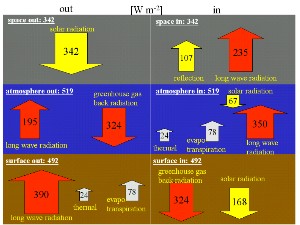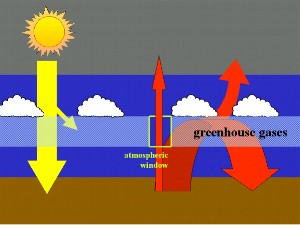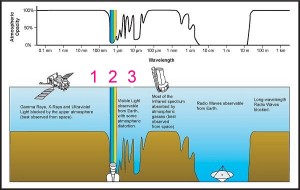 > English > Climate Encyclopaedia > Lower Atmosphere > more > 2. Radiation & greenhouse gases > - radiation
> English > Climate Encyclopaedia > Lower Atmosphere > more > 2. Radiation & greenhouse gases > - radiation
|
Lower AtmosphereRead more |
The Earth's radiation budget and the Greenhouse EffectThe climate system is driven by the energy from the Sun. Only a certain fraction of this energy reaches the surface of the Earth and causes warming. The rest of the solar energy is reflected back into space or absorbed by the atmosphere. In this section we look at how the Earth's radiation system works.
|
|
The reality is a bit more complicated since the oceans react very slowly to changes in temperature. So if the temperature rises as a result of global warming, the atmospheric temperature increases rapidly but it takes much longer for the oceans to heat up. One full turnover of the ocean water takes about 1000 years. This means that until the oceans heat up fully, the Earth is in a state of disequilibrium. Therefore, the radiation budget shown above has an uncertainty of 10 - 20%. In the following sections we assume that the equilibrium situation has been reached and the Earth system is in balance. |
|
The role of greenhouse gasesWe wear a jumper on a cold day to keep us warm. However, the jumper doesn't make the air any warmer or make our body produce more energy and the jumper doesn't produce energy itself! It simply sends part of the energy coming from our body back towards our skin causing a warm layer of air between the jumper and ourselves. This is exactly what greenhouse gases do. An increasing greenhouse effect doesn't mean that more energy comes from the Sun but that a larger proportion of the energy coming from the Earth's surface is sent back towards the surface allowing more heat to accumulate before it is released back into space.
|
Understanding the energy budgetWe measure the energy transferred into, or emitted from, a part of the system in watts per square metre (W m-2). First, let us check that that the same amount of energy comes in and goes out of the system (here we simplify by leaving out the retarding effect of the oceans): 342 W m-2 of energy enters our atmosphere directly from the Sun. About 30% of this solar energy (107 W m-2) is directly reflected back into space either from the clouds or from the surface of the Earth. This fraction of sunlight reflected directly back to space is known as the Earth's albedo, so the Earth has an average albedo of 0.3. Clouds and polar ice caps are the most efficient reflectors of solar radiation directly back into space. Definition of albedo: The ratio of the light reflected by a body to the light received by it. Albedo values range from 0 (pitch black) to 1 (perfect reflector). |
|
|
The remaining 235 W m-2 of energy from the Sun interacts either with the atmosphere or with the Earth's surface. It then returns to space as long wave infra-red radiation.
|
|
When we look at the radiation budget, we see that the surface of the Earth absorbs more energy (492 W m-2) than the total amount of energy coming from the Sun. If the system is in equilibrium this can't be true! So how does this happen? The atmosphere can either re-emit the energy it has absorbed back into space or send it back to the surface of the Earth. The presence of greenhouse gases in the atmosphere allows energy to be reflected back to the Earth making it appear that the system is unbalanced. The atmospheric windowOnly 40 W m-2 of energy is directly emitted as long wave infra-red radiation from the Earth's surface into space.
|
|
Only a small amount of the infra-red radiation emitted from the surface of the Earth can escape directly into space. Most is absorbed by the greenhouse gases present in the atmosphere. There are a few gaps in the overlapping absorption spectra of water (which absorbs roughly 60%), carbon dioxide, methane, nitrous oxide, ozone and the other greenhouse gases where infra-red radiation can't be absorbed. The most important gaps are known as the atmospheric window. Put very simply, the infrared radiation can disappear into space like heat does through a window in the roof of a greenhouse.
|
|
The analogy of the greenhouse gases to the glass of a greenhouse is not perfect. The gases interact with light, while the glass is a solid barrier which also prevents convection so that heat is retained.
|
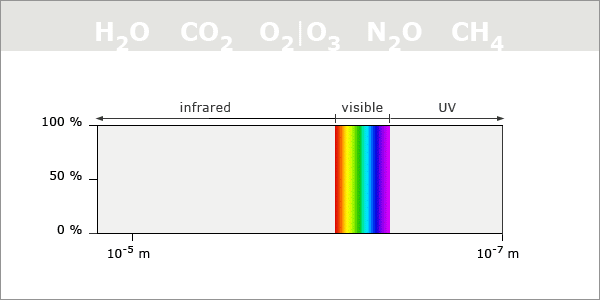 |
|
6. Where do which gases absorb?
|
|
7. How much radiation passes through the atmosphere at each wave length? |
About this page:author: Dr. Elmar Uherek - MPI for Chemistry, Mainz
|

